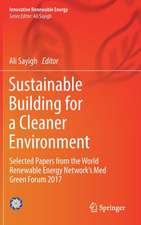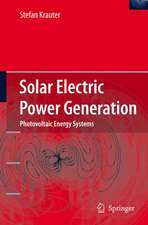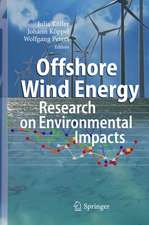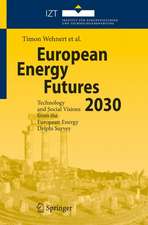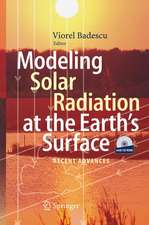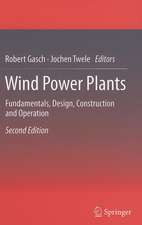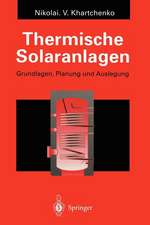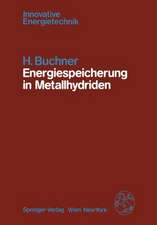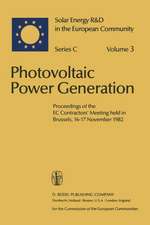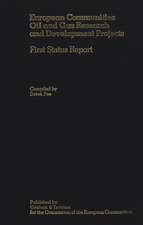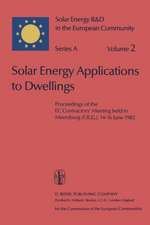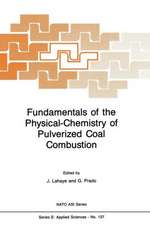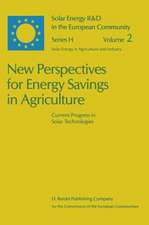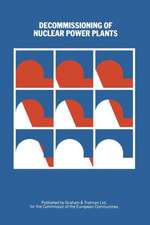Alternative Energy Sources: Green Energy and Technology
Autor Efstathios E (Stathis) Michaelidesen Limba Engleză Paperback – 22 feb 2014
The two first chapters on "energy demand and supply" and "environmental effects," set the tone as to why alternative energy is essential for the future. The third chapter gives the laws of energy conversion processes, as well as the limitations of converting one energy form to another. The section on exergy gives a quantitative background on the capability/potential of each energy source to produce power. The fourth, fifth and sixth chapters are expositions of fission and fusion nuclear energy, the power plants that may produce power from these sources and the issues that will frame the public debate on nuclear energy. The following five chapters include descriptions of the most common renewable energy sources (wind, solar, geothermal, biomass, hydroelectric) some ofthe less common sources (e.g. tidal and wave energy). The emphasis of these chapters will be on the global potential of each source, the engineering/technical systems that are used in harnessing the potential of each source, the technological developments that will contribute to wider utilization of the sources and environmental effects associated with their wider use. The last three chapters are: "energy storage," which will become an important issue if renewable energy sources are used widely.
The fourteen chapters in the book have been chosen so that one may fit a semester University course around this book. At the end of every chapter, there are 10-20 problems and 1-3 suggestions of semester projects that may be assigned to students for further research.
| Toate formatele și edițiile | Preț | Express |
|---|---|---|
| Paperback (1) | 536.49 lei 6-8 săpt. | |
| Springer Berlin, Heidelberg – 22 feb 2014 | 536.49 lei 6-8 săpt. | |
| Hardback (1) | 711.21 lei 6-8 săpt. | |
| Springer Berlin, Heidelberg – 16 ian 2012 | 711.21 lei 6-8 săpt. |
Din seria Green Energy and Technology
- 18%
 Preț: 943.43 lei
Preț: 943.43 lei - 20%
 Preț: 629.52 lei
Preț: 629.52 lei - 18%
 Preț: 1124.92 lei
Preț: 1124.92 lei - 18%
 Preț: 947.35 lei
Preț: 947.35 lei - 15%
 Preț: 655.92 lei
Preț: 655.92 lei - 18%
 Preț: 957.62 lei
Preț: 957.62 lei - 18%
 Preț: 789.52 lei
Preț: 789.52 lei - 17%
 Preț: 464.56 lei
Preț: 464.56 lei - 15%
 Preț: 645.79 lei
Preț: 645.79 lei - 18%
 Preț: 903.93 lei
Preț: 903.93 lei - 24%
 Preț: 1322.09 lei
Preț: 1322.09 lei - 18%
 Preț: 890.54 lei
Preț: 890.54 lei - 18%
 Preț: 1115.46 lei
Preț: 1115.46 lei - 18%
 Preț: 1117.03 lei
Preț: 1117.03 lei - 18%
 Preț: 949.73 lei
Preț: 949.73 lei - 18%
 Preț: 892.11 lei
Preț: 892.11 lei - 15%
 Preț: 648.24 lei
Preț: 648.24 lei - 18%
 Preț: 997.09 lei
Preț: 997.09 lei - 15%
 Preț: 579.81 lei
Preț: 579.81 lei - 18%
 Preț: 1123.15 lei
Preț: 1123.15 lei - 18%
 Preț: 961.41 lei
Preț: 961.41 lei - 17%
 Preț: 490.23 lei
Preț: 490.23 lei - 18%
 Preț: 904.60 lei
Preț: 904.60 lei - 15%
 Preț: 643.34 lei
Preț: 643.34 lei -
 Preț: 287.91 lei
Preț: 287.91 lei - 24%
 Preț: 634.05 lei
Preț: 634.05 lei -
 Preț: 379.40 lei
Preț: 379.40 lei - 18%
 Preț: 783.20 lei
Preț: 783.20 lei - 18%
 Preț: 1394.84 lei
Preț: 1394.84 lei - 18%
 Preț: 1691.57 lei
Preț: 1691.57 lei - 18%
 Preț: 1112.48 lei
Preț: 1112.48 lei - 15%
 Preț: 592.61 lei
Preț: 592.61 lei - 18%
 Preț: 952.09 lei
Preț: 952.09 lei - 18%
 Preț: 944.19 lei
Preț: 944.19 lei - 18%
 Preț: 891.33 lei
Preț: 891.33 lei - 18%
 Preț: 1252.44 lei
Preț: 1252.44 lei - 18%
 Preț: 789.52 lei
Preț: 789.52 lei - 20%
 Preț: 566.30 lei
Preț: 566.30 lei - 18%
 Preț: 1113.71 lei
Preț: 1113.71 lei - 18%
 Preț: 1114.24 lei
Preț: 1114.24 lei - 24%
 Preț: 590.60 lei
Preț: 590.60 lei - 20%
 Preț: 567.50 lei
Preț: 567.50 lei - 24%
 Preț: 907.50 lei
Preț: 907.50 lei - 18%
 Preț: 952.89 lei
Preț: 952.89 lei - 18%
 Preț: 952.89 lei
Preț: 952.89 lei - 18%
 Preț: 950.52 lei
Preț: 950.52 lei
Preț: 536.49 lei
Preț vechi: 631.16 lei
-15% Nou
Puncte Express: 805
Preț estimativ în valută:
102.67€ • 106.79$ • 84.76£
102.67€ • 106.79$ • 84.76£
Carte tipărită la comandă
Livrare economică 14-28 aprilie
Preluare comenzi: 021 569.72.76
Specificații
ISBN-13: 9783642439070
ISBN-10: 3642439071
Pagini: 480
Ilustrații: XVIII, 462 p.
Dimensiuni: 155 x 235 x 30 mm
Greutate: 0.67 kg
Ediția:2012
Editura: Springer Berlin, Heidelberg
Colecția Springer
Seria Green Energy and Technology
Locul publicării:Berlin, Heidelberg, Germany
ISBN-10: 3642439071
Pagini: 480
Ilustrații: XVIII, 462 p.
Dimensiuni: 155 x 235 x 30 mm
Greutate: 0.67 kg
Ediția:2012
Editura: Springer Berlin, Heidelberg
Colecția Springer
Seria Green Energy and Technology
Locul publicării:Berlin, Heidelberg, Germany
Public țintă
GraduateCuprins
Energy Demand and Supply.- Environmental effects of energy use – The laws of thermodynamics.- Nuclear energy.- Nuclear Power Plants.- Fusion energy.- Wind Power.- Geothermal Energy.- Solar Energy.- Biomass/biofuels.- Other renewable sources of energy.- Energy storage.- Energy Conservation.- Economics of Energy Projects.
Notă biografică
Efstathios E. (Stathis) Michaelides, Ph.D., P.E. is Professor and Chair of the Department of Mechanical Engineering. His Educational Background is B.A. Oxford University M.S., Ph.D. Brown University. His Areas of Teaching Interest are Energy Conversion, Thermodynamics and Fluid Dynamics. His Areas of Research Interest are Thermodynamics of Advanced Energy Conversion Devices, Energy Systems, Energy Conservation, HVAC, Multiphase Flow and Heat Transfer, Particulate Flow and Environmental Fluid Dynamics, Sediment Flow, Separation Processes, Materials Handling.
Textul de pe ultima copertă
Alternative Energy Sources is designed to give the reader, a clear view of the role each form of alternative energy may play in supplying the energy needs of the human society in the near and intermediate future (20-50 years).
The two first chapters on energy demand and supply and environmental effects, set the tone as to why the widespread use of alternative energy is essential for the future of human society. The third chapter exposes the reader to the laws of energy conversion processes, as well as the limitations of converting one energy form to another. The sections on exergy give a succinct, quantitative background on the capability/potential of each energy source to produce power on a global scale. The fourth, fifth and sixth chapters are expositions of fission and fusion nuclear energy. The following five chapters (seventh to eleventh) include detailed descriptions of the most common renewable energy sources – wind, solar, geothermal, biomass, hydroelectric – and some of the less common sources, such as tidal and wave energy. The emphasis of these chapters is on the global potential of each source; the engineering/technical systems that are currently used in harnessing the potential of each one of these energy sources; the technological developments that will contribute to wider utilization of the sources; and the environmental effects associated with their current and their wider use. The last three chapters are: energy storage, which is the main limitation of the wider use of solar and wind power and will become an important issue if renewable energy sources are to be used widely; energy conservation, which appears to be everyone’s favorite issue, but by itself is not a solution to our energy challenge; and energy economics, a necessary consideration in market-driven economies.
The fourteen chapters in the book have been chosen so that one may fit a semester University course around this book. At the end of every chapter, there are 12-20 problems including 1-3 thought-provoking questions on a major socio-economic issue related to energy. In instructor may assign essays, discussions, presentations or design a further research project around these problems.
The two first chapters on energy demand and supply and environmental effects, set the tone as to why the widespread use of alternative energy is essential for the future of human society. The third chapter exposes the reader to the laws of energy conversion processes, as well as the limitations of converting one energy form to another. The sections on exergy give a succinct, quantitative background on the capability/potential of each energy source to produce power on a global scale. The fourth, fifth and sixth chapters are expositions of fission and fusion nuclear energy. The following five chapters (seventh to eleventh) include detailed descriptions of the most common renewable energy sources – wind, solar, geothermal, biomass, hydroelectric – and some of the less common sources, such as tidal and wave energy. The emphasis of these chapters is on the global potential of each source; the engineering/technical systems that are currently used in harnessing the potential of each one of these energy sources; the technological developments that will contribute to wider utilization of the sources; and the environmental effects associated with their current and their wider use. The last three chapters are: energy storage, which is the main limitation of the wider use of solar and wind power and will become an important issue if renewable energy sources are to be used widely; energy conservation, which appears to be everyone’s favorite issue, but by itself is not a solution to our energy challenge; and energy economics, a necessary consideration in market-driven economies.
The fourteen chapters in the book have been chosen so that one may fit a semester University course around this book. At the end of every chapter, there are 12-20 problems including 1-3 thought-provoking questions on a major socio-economic issue related to energy. In instructor may assign essays, discussions, presentations or design a further research project around these problems.
Caracteristici
Includes two chapters on nuclear energy by fission and one on fusion energy Contains detailed chapter on "energy storage" Assumes minimum prior knowledge on behalf of the reader and imparts some of the pre-requisite knowledge Includes supplementary material: sn.pub/extras






